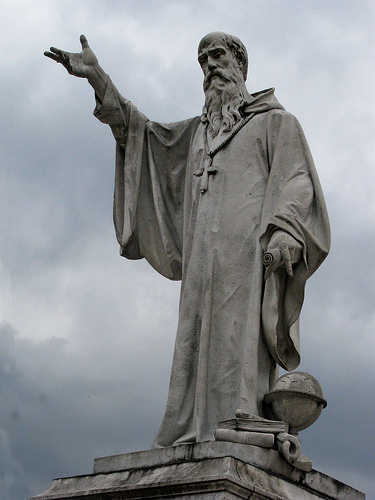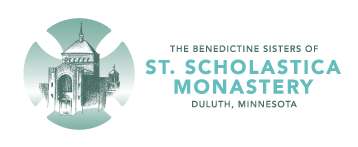In May, Sister Mary Catherine Shambour participated in a Rome Renewal experience with Sisters from other Benedictine communities.
 Another Sister writes about visiting Norcia, the birthplace of St. Benedict. “I visited the town of Norcia, located in the mountains about 70 miles northwest of Rome. Saint Benedict was born there in 480 AD; a church has been built on the site of his grandparents’ home, parts of which are still visible in the crypt. In the main piazza in the center of the city, just outside the church, stands this grand statue of St. Benedict, preaching and calling to the world. (The nearby gift shop sold a similar picture with a beautiful clear blue sky; the gray clouds on the day of my visit seem fitting for our 21st century Church.)
Another Sister writes about visiting Norcia, the birthplace of St. Benedict. “I visited the town of Norcia, located in the mountains about 70 miles northwest of Rome. Saint Benedict was born there in 480 AD; a church has been built on the site of his grandparents’ home, parts of which are still visible in the crypt. In the main piazza in the center of the city, just outside the church, stands this grand statue of St. Benedict, preaching and calling to the world. (The nearby gift shop sold a similar picture with a beautiful clear blue sky; the gray clouds on the day of my visit seem fitting for our 21st century Church.)
Norcia is still a very traditional place. Besides tourists come to see the birthplace of St. Benedict, they get income from hikers climbing in the mountains (we saw snow caps as we came up the steep and windy mountain passes). They are also famous for their hams, sausages and salamis, which one can see hanging in stores all over town. They sell a variety of products made from wild boars – and the head of a wild boar, stuffed and mounted, is as common in Norcia as are ranks of deer antlers in Northern Minnesota.
“What good does it do for a 21st century American Benedictine to visit this small town a remote area of Italy?” Well, I discovered that there were hermit-monks living in the area when he grew up. St. Eutizio lived in a cave just down the road from Norcia, and was reknowned for his holy way of life – so much so that St. Gregory recounted the story of his life in one of the other volumes of his Dialogues. Growing up in a devoutly Chrisitan household in a remote region, he surely knew of these monks, of their way of life, and their connection to the Gospel. There is no record that he was particularly attracted to them – but certainly there was an image, a pattern, to which he could later turn.
After two weeks of visiting house churches, basilicas, the ruins of classical Rome, the city of Norcia stands in sharp contrast. It is still contained within medieval walls with seven gates – with small shops selling bread, church bells ringing to tell the time, cobblestone streets and a friendly, slower pace of life. We could walk from one side of the city to the other in a few minutes. There were no trains, trams, or buses; no pickpockets to worry about; no jostling crowds.
Even all these centuries later, it was easy to understand the shock that Benedict must have felt when he came to Rome to study. “The cosmopolitan ways of the Roman culture of the time could easily be deeply offensive and untenable to a youth from Norcia. He was probably not alone – many youths from remote areas may have abandoned studies to return home. Benedict’s spark of genius was to respond not only to the superficial differences, but the deep motivations behind the behaviors which so shocked him. Out of that shock, eventually, was born his Rule and it’s plan for a way of living that is ‘different from the world’s ways.'”
Photo: Statue of Benedict, Norcia Town Square,
